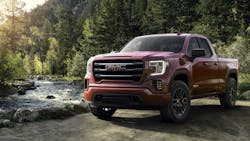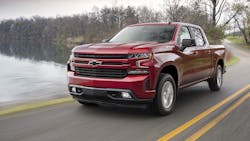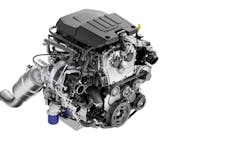GMC's next-gen Sierra 1500 lineup will again include an Elevation edition—although it's now more focused on appearance than sport truck performance, which is how the Elevation came onto the scene among the previous-generation Sierras in 2015. But on that note, its engine may be a surprise high point.
The Sierra Elevation, which will be available starting this fall, joins the SLT, off-road-themed AT4, and high-society Denali trims that will be available on the 2019 Sierra 1500. With their tall front grille and curved "blade"-style headlights, the new Sierra 1500s all are designed for a standout look.
The Elevation model takes that farther, however, with body-color door handles, bumpers, and grille surround as well as a black grille insert, tow hooks, side window trim, and 20-in. wheels.
To outfit the Elevation for more serious off-road use, you'll want the available X31 Off Road package, which includes a specially tuned suspension with Rancho shocks, locking rear differential, protective underbody skid plates, heavy-duty air filter, dual exhaust system, a two-speed transfer case with low-range gearing, all-terrain tires, and hill descent control.
Or for towing, the Sierra's available ProGrade trailering system incorporating multiple cameras and backing guidance overlays is designed to make backing and hooking up to a trailer simple even for noobs.
Technical marvel
However, a performance high point—or certainly point of interest—for the Sierra Elevation is its standard new gasoline 4-cyl. turbo 2.7L engine that General Motors has designed specifically for trucks. It will also be standard on the Sierra 1500's sibling, the Chevrolet Silverado 1500, in its LT and RST trims. And it's no slouch: the seemingly diminutive engine will power these half-ton pickups from 0-60 mph in under 7 seconds.
The engine will be good for an SAE-rated 310 hp. at 5,600 rpm and 348 lbs.-ft. of torque. In what way was this powerplant designed for trucks? For starters, it's got a "broad, flat" torque curve, where peak torque is available from just 1,500 rpm up through 4,000 rpm. To help make that happen, GM gave the engine an extended piston stroke, which allows for improved combustion and higher cylinder compression.
And to help the engine components stand up to the high pressure, the 2.7L four-banger boasts a forged steel crankshaft and connecting rods and pistons made of an aluminum alloy with a cast-iron insert.
To allow the 2.7L's extended and flat torque curve, however, GM mainly credits the engine's dual overhead electromechanical camshafts with variable valve timing systems. The systems alternate between high valve lift for maximum power, low valve lift for somewhat reduced power but higher efficiency, and an Active Fuel Management mode where two of the four cylinders can actually be shut down when not needed to maximize fuel efficiency. That's a first for GM with a 4-cyl. powerplant.
"It's like having different engines for low- and high-rpm performance," noted Tom Sutter, GM's chief engineer of the new 2.7L.
Not only is the engine expected to be more fuel efficient than the 4.3L gasoline V6 that's the current standard and will continue in the current Chevy Silverado, it's also much lighter, thanks in part to two less cylinders and an aluminum block and cylinder head. And lighter weight overall will improve the Sierra Elevation's and sibling Silverado's fuel efficiency overall as well.
The Sierra 1500 Elevation will also be available with 5.3L and 6.2L gasoline V8 engines, but the 2.7L 4-cyl. turbo isn't far behind those, considering. The 5.3L V8 is rated at 355 hp. at 5,600 rpm and 383 lbs.-ft. of torque at 4,100 rpm, and the 6.2L V8 makes 420 hp. at 5,600 rpm and 460 lbs.-ft. of torque at 4,100 rpm.
About the Author
Aaron Marsh
Aaron Marsh is a former senior editor of FleetOwner, who wrote for the publication from 2015 to 2019.


